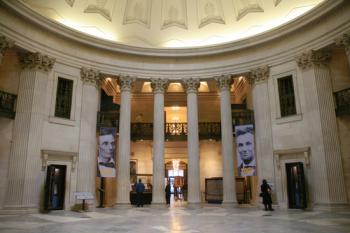An Overview of the 1st Amendment
 First Amendment: Religion and Expression
First Amendment: Religion and Expression
What is the First Amendment?
Congress shall make no law respecting an establishment of religion, or prohibiting the free exercise thereof; or abridging the freedom of speech, or of the press; or the right of the people peaceably to assemble, and to petition the Government for a redress of grievances.
The First Amendment Defined:
The First Amendment is a part of the Bill of Rights, which are the first 10 Amendments to the United States Constitution and the framework to elucidate upon the freedoms of the individual. The Bill of Rights were proposed and sent to the states by the first session of the First Congress. They were later ratified on December 15, 1791.
The first 10 Amendments to the United States Constitution were introduced by James Madison as a series of legislative articles and came into effect as Constitutional Amendments following the process of ratification by three-fourths of the States on December 15, 1791.
Stipulations of the 1st Amendment:
The First Amendment to the United States Constitution prohibits the passing or creation of any law which establishes a religious body and directly impedes an individual’s right to practice whichever religion they see fit.
The First Amendment to the United States Constitution is a part of the Bill of Rights and the amendment which disables an entity or individual from practicing or enforcing a religious viewpoint which infringes on the freedom of speech, the right peaceable assemble, the freedom of the press, or which prohibits the petitioning for a governmental evaluation of grievances.
In its infancy, the First Amendment only applied to laws enacted by Congress; however, the following Gitlow v. New York, the Supreme Court developed that the Due Process Clause attached to the Fourteenth Amendment applies the fundamental aspects of the First Amendment to each individual state, including all local governments within those states.
The Establishment clause of the First Amendment is the primary pronouncement in the Amendment, stating that Congress cannot institute a law to establish a national religion for the preference of the U.S. government states that one religion does not favor another. As a result, the Establishment Clause effectively created a wall of separation between the church and state.
How the First Amendment was created:
When the original constitution was created there was significant opposition due to the lack of adequate guarantees for civil freedoms. To offer such liberties, the First Amendment (in addition to the rest of the Bill of Rights) was offered to the states for ratification on September 25, 1789 and later adopted on December 15, 1791.
Court Cases tied into the 1st Amendment
In Sherbert v. Verner, the Supreme Court applied the strict scrutiny standard of review to the Establishment Clause, ruling that a state must demonstrate an overwhelming interest in restricting religious activities.
In Employment Division v Smith, the Supreme Court went away from this standard by permitting governmental actions that were neutral regarding religious choices.
Debs v. United States on June 16, 1919 tested the limits of free speech in regards to the “clear and present danger” test.
1st Amendment: Freedom of Speech
Freedom of speech in the United States is protected by the First Amendment and is re-established in the majority of state and federal laws. This particular clause typically protects and individual’s right to partake in even distasteful rhetoric, such as racist or sexist comments and distasteful remarks towards public policy.
Speech directed towards some subjects; however, such as child pornography or speech that incites an imminent threat, as well commercial forms of speech are regulated.
State Timeline for Ratification of the Bill of Rights
New Jersey:November 20, 1789; rejected article II
Maryland:December 19, 1789; approved all
North Carolina:December 22, 1789; approved all
South Carolina: January 19, 1790; approved all
New Hampshire: January 25, 1790; rejected article II
Delaware: January 28, 1790; rejected article I
New York: February 27, 1790; rejected article II
Pennsylvania: March 10, 1790; rejected article II
Rhode Island: June 7, 1790; rejected article II
Vermont: November 3, 1791; approved all
Virginia: December 15, 1791; approved all
Georgia, Massachusetts and Connecticut did not ratify the first 10 Amendments until 1939
Related Topics
- Dawes Act Text
- Articles of Confederation Overview
- Elbridge Gerry
- Salary and Benefits Overview
- An Overview of the Federalist Papers
- An Overview of the 8th Amendment
- Declaration of the Rights of Man
- Judicial Review Overview
- Quick History Overview
- The Basis of Constitutional Law Overview